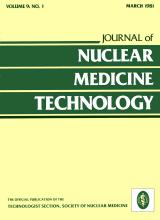Abstract
We evaluate a new accessory for reducing personnel radiation exposure. The disposable accessory, a “bypass device,” couples a conventional hypodermic needle and syringe. As saline from the syringe is expelled, the radionuclide dose, which is stored in a remote shielded reservoir resting on a surface adjacent to the injection site, is driven out through the hypodermic needle. Dosimetry studies in conjunction with the most frequently used technetium compounds indicate that the use of the bypass device reduces the exposure rate to the fingertips by factors of approximately 6,700 and 670 compared to unshielded and shielded syringes, respectively. In addition to the substantial reductions in exposure, the manipulative ability when administering injections provided by the bypass device was judged to be very nearly equivalent to that with unshielded syringes. The bypass device was also highly effective in such special applications as bolus injections.







